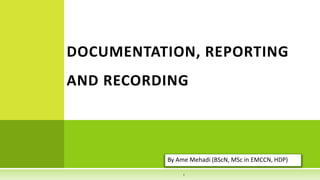This document discusses documentation, reporting, and record keeping in emergency and critical care settings. It covers the purpose of documentation to ensure continuity of care, meet legal requirements, and provide information for research and education. The document outlines various types of records including nursing assessments, care plans, vital signs charts, medication records, incident reports, and informed consent forms. It provides guidance on documentation principles, such as writing objectively, legibly, and avoiding abbreviations. Maintaining accurate and comprehensive patient records is important for patient safety, clinical governance, and potential medico-legal cases.


![ Documentation, recording & reporting [1 hr.]
Purpose of documentation
Types of report
Patient parameters recording guideline
Guidelines for reporting client data
Confidentiality of records
3](https://image.slidesharecdn.com/9-231223181641-ca435028/85/9-Documentation-Recording-and-Reporting-pptx-3-320.jpg)











































